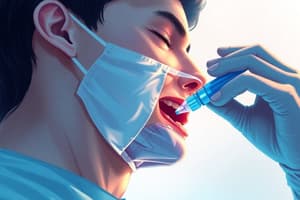Podcast
Questions and Answers
What is the name of the part of the pharynx located behind the mouth?
What is the name of the part of the pharynx located behind the mouth?
Oropharynx
When is suctioning used?
When is suctioning used?
When coughing does not adequately clear respiratory secretions and secretions are interfering with oxygenation.
Which of the following are types of suctioning? (Select all that apply)
Which of the following are types of suctioning? (Select all that apply)
- Nasogastric
- Orogastric
- Oropharyngeal/nasopharyngeal (correct)
- Endotracheal (correct)
- Orotracheal/nasotracheal (correct)
LPNs can suction the nasal passages beyond the point where they normally narrow without additional education and an order.
LPNs can suction the nasal passages beyond the point where they normally narrow without additional education and an order.
LPNs can carry out nasopharyngeal swabs after successfully completing additional education.
LPNs can carry out nasopharyngeal swabs after successfully completing additional education.
LPNs can insert nasogastric tubes.
LPNs can insert nasogastric tubes.
LPNs can provide tracheostomy care to clients who have well-established tracheostomies after successfully completing additional education and with an order.
LPNs can provide tracheostomy care to clients who have well-established tracheostomies after successfully completing additional education and with an order.
What are some specific signs that a client might need suctioning?
What are some specific signs that a client might need suctioning?
What assessments would you perform prior to suctioning?
What assessments would you perform prior to suctioning?
How often would you suction a patient?
How often would you suction a patient?
What should you monitor during suctioning?
What should you monitor during suctioning?
What are some of the equipment needed for suctioning?
What are some of the equipment needed for suctioning?
What should you do before suctioning?
What should you do before suctioning?
What are the steps for performing oropharyngeal suctioning?
What are the steps for performing oropharyngeal suctioning?
What should you do if SpO2 drops or respiratory distress develops during nasopharyngeal suctioning?
What should you do if SpO2 drops or respiratory distress develops during nasopharyngeal suctioning?
What are the two main sections of the pharynx?
What are the two main sections of the pharynx?
When would suctioning be used?
When would suctioning be used?
Which of the following types of suctioning requires a sterile procedure?
Which of the following types of suctioning requires a sterile procedure?
LPNs can perform which of the following procedures?
LPNs can perform which of the following procedures?
According to the slides, what are some signs that a client might need suctioning?
According to the slides, what are some signs that a client might need suctioning?
What are the two main types of suctioning?
What are the two main types of suctioning?
What should be done before suctioning a client?
What should be done before suctioning a client?
What equipment is used for suctioning?
What equipment is used for suctioning?
How do you prep the suction catheter before performing oropharyngeal suctioning?
How do you prep the suction catheter before performing oropharyngeal suctioning?
What is the recommended catheter insertion depth for adults during nasopharyngeal suctioning?
What is the recommended catheter insertion depth for adults during nasopharyngeal suctioning?
How long do you apply suction for on the catheter during nasopharyngeal suctioning?
How long do you apply suction for on the catheter during nasopharyngeal suctioning?
It is important to rotate the catheter back-and-forth between your thumb and forefinger while slowly withdrawing it after nasopharyngeal suctioning.
It is important to rotate the catheter back-and-forth between your thumb and forefinger while slowly withdrawing it after nasopharyngeal suctioning.
What should be done to the suction catheter after nasopharyngeal suctioning?
What should be done to the suction catheter after nasopharyngeal suctioning?
It is okay to leave the nasal cannula on during oropharyngeal suctioning.
It is okay to leave the nasal cannula on during oropharyngeal suctioning.
When is it important to reapply the nasal cannula or mask during suctioning?
When is it important to reapply the nasal cannula or mask during suctioning?
Flashcards
Oropharynx
Oropharynx
The space behind the mouth that stretches from the soft palate to the hyoid bone and contains the tonsils.
Nasopharynx
Nasopharynx
The area behind the nose that extends to the soft palate.
Suctioning
Suctioning
The act of removing secretions (mucus, saliva) from the respiratory tract using suction.
Oropharyngeal/Nasopharyngeal suctioning
Oropharyngeal/Nasopharyngeal suctioning
Describes the part of suctioning that involves the back of the throat.
Signup and view all the flashcards
Orotracheal/Nasotracheal suctioning
Orotracheal/Nasotracheal suctioning
This type of suctioning involves the trachea (windpipe).
Signup and view all the flashcards
Tracheostomy/Endotracheal suctioning
Tracheostomy/Endotracheal suctioning
Suctioning through an artificial airway like a tracheostomy or endotracheal tube.
Signup and view all the flashcards
Scope of Practice
Scope of Practice
The ability to perform a particular procedure based on your training and legal authorization.
Signup and view all the flashcards
LPN Nasal Suctioning Restrictions
LPN Nasal Suctioning Restrictions
A licensed practical nurse (LPN) is allowed to suction the nasal passages before they narrow, but not beyond that point.
Signup and view all the flashcards
LPN Nasopharyngeal Swabbing
LPN Nasopharyngeal Swabbing
LPNs are allowed to perform nasopharyngeal swabs after additional training and with an order from a doctor.
Signup and view all the flashcards
Prohibited Procedures for LPNs
Prohibited Procedures for LPNs
Procedures that are not allowed for LPNs.
Signup and view all the flashcards
LPN Tracheostomy Care
LPN Tracheostomy Care
LPNs can provide tracheostomy care to clients with established tracheostomies after receiving additional education and an order from a doctor.
Signup and view all the flashcards
Suctioning Assessment
Suctioning Assessment
The process of evaluating a client's need for suctioning.
Signup and view all the flashcards
Client Difficulty Clearing Secretions
Client Difficulty Clearing Secretions
Inability to clear secretions by coughing.
Signup and view all the flashcards
Abnormal Respiratory Rate
Abnormal Respiratory Rate
Abnormal respiratory rate (too fast or too slow).
Signup and view all the flashcards
Adventitious Lung Sounds
Adventitious Lung Sounds
Sounds in the lungs that are not normally present, like wheezing or crackling.
Signup and view all the flashcards
Nasal Secretions
Nasal Secretions
The presence of nasal mucus or discharge.
Signup and view all the flashcards
Gurgling
Gurgling
A rattling or bubbling sound in the throat caused by secretions.
Signup and view all the flashcards
Drooling
Drooling
Excessive saliva spilling from the mouth.
Signup and view all the flashcards
Vomitus in the Mouth
Vomitus in the Mouth
Vomitus in the mouth or throat.
Signup and view all the flashcards
Ineffective Coughing
Ineffective Coughing
Coughing without being able to clear secretions.
Signup and view all the flashcards
Vital Signs
Vital Signs
Vital signs (temperature, pulse, respirations, blood pressure).
Signup and view all the flashcards
Pulse Oximetry
Pulse Oximetry
A device that measures the oxygen levels in the blood.
Signup and view all the flashcards
Lung Assessment
Lung Assessment
Listening to sounds in the lungs with a stethoscope.
Signup and view all the flashcards
Suctioning Frequency
Suctioning Frequency
Suctioning is not done routinely, but is done as needed based on the clients condition.
Signup and view all the flashcards
Monitoring During Suctioning
Monitoring During Suctioning
Monitoring the client's color, oxygen levels in the blood, pulse, breathing, and sounds during suctioning.
Signup and view all the flashcards
Sterile Suction Catheter
Sterile Suction Catheter
A sterile tube used to remove secretions from the airway.
Signup and view all the flashcards
Water-Soluble Lubricant
Water-Soluble Lubricant
Used to lubricate the suction catheter.
Signup and view all the flashcards
Gloves
Gloves
Protective gear used to prevent exposure to secretions.
Signup and view all the flashcards
Suction Regulator
Suction Regulator
A device used to regulate the suction pressure.
Signup and view all the flashcards
Suction Bowl
Suction Bowl
A container used to collect the secretions during suctioning.
Signup and view all the flashcards
Face Shield
Face Shield
Used to protect the eyes from splashes during suctioning.
Signup and view all the flashcards
Towel
Towel
Used to absorb any spills during suctioning.
Signup and view all the flashcards
Water
Water
Used to clean the suction catheter and the bowl.
Signup and view all the flashcards
FiO2
FiO2
The percentage of inspired oxygen being delivered to the patient.
Signup and view all the flashcards
SpO2
SpO2
The amount of oxygen in the blood, measured by a pulse oximeter.
Signup and view all the flashcards
Hypoxia
Hypoxia
A condition where the body's tissues are not getting enough oxygen.
Signup and view all the flashcards
Oxygen Toxicity
Oxygen Toxicity
A condition where the body's tissues have too much oxygen, which can be toxic.
Signup and view all the flashcards
Low Flow Oxygen
Low Flow Oxygen
A type of oxygen delivery system that delivers a flow rate lower than the patient's inspiratory flow rate.
Signup and view all the flashcards
High Flow Oxygen
High Flow Oxygen
A type of oxygen delivery system that delivers a flow rate higher than the patient's inspiratory flow rate, ensuring a consistent FiO2.
Signup and view all the flashcards
Incentive Spirometry
Incentive Spirometry
A method that uses a visual tool to encourage deep breathing.
Signup and view all the flashcards
Nasal Cannula (NC)
Nasal Cannula (NC)
A type of oxygen delivery device that sits over the nose, providing a low flow of oxygen.
Signup and view all the flashcards
Simple Mask (SM)
Simple Mask (SM)
A type of oxygen delivery device that covers the nose and mouth, providing a low flow of oxygen.
Signup and view all the flashcards
Non-Rebreathing Mask (NRB)
Non-Rebreathing Mask (NRB)
A type of oxygen delivery device that creates a seal over the nose and mouth, providing a higher flow of oxygen with a reservoir bag.
Signup and view all the flashcards
Aerosol Mask
Aerosol Mask
A type of oxygen delivery device that uses a nebulizer to deliver oxygen and medication as a mist.
Signup and view all the flashcards
Face Tent
Face Tent
A type of oxygen delivery device that covers the head and neck, providing a high flow of oxygen.
Signup and view all the flashcards
OptiFlow
OptiFlow
A type of oxygen delivery device that combines humidification with high-flow oxygen therapy.
Signup and view all the flashcards
Bag-Valve-Mask (BVM)
Bag-Valve-Mask (BVM)
A hand-held device used to deliver breaths to a patient.
Signup and view all the flashcards
CPAP
CPAP
A type of breathing machine that delivers continuous positive airway pressure.
Signup and view all the flashcards
Respiratory Rate
Respiratory Rate
The rate and depth of breathing.
Signup and view all the flashcards
Oxygenation Management
Oxygenation Management
The use of various techniques to promote oxygenation, including positioning, deep breathing exercises, and oxygen therapy.
Signup and view all the flashcards
High Flow System
High Flow System
A type of oxygen delivery system that delivers a precise concentration of oxygen.
Signup and view all the flashcards
Respiratory Medication Delivery
Respiratory Medication Delivery
The use of medications to improve respiratory function.
Signup and view all the flashcards
Metered Dose Inhaler (MDI)
Metered Dose Inhaler (MDI)
A type of medication delivery device that uses a pressurized canister to deliver a measured dose of medication.
Signup and view all the flashcards
Small Volume Nebulizer (SVN)
Small Volume Nebulizer (SVN)
A type of medication delivery device that uses a small machine to convert medication into a fine mist.
Signup and view all the flashcards
Dry Powder Inhaler (DPI)
Dry Powder Inhaler (DPI)
A type of medication delivery device that contains a powder form of medication.
Signup and view all the flashcards
Respiratory Assessment
Respiratory Assessment
The act of assessing a patient's respiratory status.
Signup and view all the flashcards
Respiratory Documentation
Respiratory Documentation
The process of documenting a patient's respiratory status and any interventions provided.
Signup and view all the flashcards
Oxygen Tank
Oxygen Tank
A portable tank that is used to store medical oxygen.
Signup and view all the flashcards
Oxygen Concentrator
Oxygen Concentrator
A device that filters air and concentrates oxygen, providing a continuous supply of oxygen for home use.
Signup and view all the flashcards
Oxygen Regulator
Oxygen Regulator
A device that regulates the amount of oxygen being delivered to the patient.
Signup and view all the flashcards
Oxygen Flowmeter
Oxygen Flowmeter
A device that measures the flow rate of oxygen being delivered to the patient.
Signup and view all the flashcardsStudy Notes
Suctioning Overview
- Suctioning is a procedure used to remove secretions from the respiratory tract when a client cannot clear them through coughing.
- This procedure is necessary when secretions interfere with oxygenation.
- Oropharyngeal/nasopharyngeal suctioning treats the back of the throat.
- Orotracheal/nasotracheal suctioning involves insertion into the trachea.
- Tracheostomy or endotracheal suctioning requires sterile technique.
Pharyngeal Anatomy
- The oropharynx lies behind the mouth, extending from the soft palate to the hyoid bone. It contains the tonsils.
- The nasopharynx is positioned behind the nose, reaching to the soft palate.
Suctioning - When It's Used
- Suctioning is used when a client's cough is ineffective in clearing respiratory secretions that impede oxygenation.
- Conditions requiring suctioning include secretions in the mouth, abnormal respiratory rate, or adventitious breath sounds (e.g., gurgling, drooling).
- Secretions in the oropharyngeal or nasopharyngeal area or within an artificial airway are all reasons to consider suctioning.
LPN Scope of Practice Guidelines - Restrictions
- LPNs are restricted from inserting nasogastric (NG), orogastric (OG) tubes, and nasopharyngeal washes.
- LPNs can perform suctioning of the nasal passages beyond the point of normal narrowing (after completing additional education and receiving a physician order).
- LPNs can perform nasopharyngeal swabs (after completing additional education).
- LPNs can manage well-established tracheostomy care (after completing additional education).
Suctioning Equipment
- Sterile suction catheter
- Water-soluble lubricant
- Gloves
- Suction regulator/container
- Bowl
- Face shield
- Towel
- Water
Procedure for Suctioning
- Assess the client's need for suctioning.
- Use either wall or portable suction.
- Set the suction regulator to 100-150 mmHg (adults), 7-15 mmHg (portable).
- Apply sterile gloves and a protective mask.
- Fill a sterile bowl with 100mL of sterile normal saline.
- Connect the suction catheter or Yankauer (tonsil suction) to the tubing.
- May leave nasal cannula in place (remove masks if SpO2 drops or respiratory distress develops).
Oropharyngeal Suctioning
- Lubricate the suction catheter with water.
- Insert the catheter or Yankauer into the client's mouth.
- With suction applied, move the catheter around the mouth, pharynx, and gum line until secretions are cleared.
- Encourage the client to cough.
- Repeat if needed.
- Remove secretions from the catheter with suction water or saline; clean and dry the catheter for reuse.
- Replace oxygen (O2) if required.
Nasopharyngeal Suctioning
- Apply sterile gloves.
- Attach the suction tubing (with the non-sterile hand).
- Suction a small amount of normal saline from the bowl.
- Lubricate the catheter.
- Insert the catheter into the nostril during inhalation.
- Advance the catheter to the back of the pharynx without applying suction.
- Gently withdraw the catheter while rotating it.
- Rinse the catheter and dry it for reuse.
- Turn the suction off.
- In adults, insert the catheter about 20 cm from the tip of the nose to the base of the earlobe.
- Apply intermittent suction for up to 10 seconds, releasing the thumb from the catheter valve after each suction.
- Slowly withdraw the catheter, rotating it back and forth, between the thumb and forefinger.
- Rinse the catheter and store it in a clean, dry area for reuse.
Assessment Questions
- How do you determine if a client needs suctioning?
- What are the signs indicative of suctioning needs?
- Which assessment tools should be used prior to suctioning?
- How often should suctioning be performed?
- What parameters should be monitored during suctioning?
Assessment Answers
- Inability to clear secretions through coughing, abnormal respiratory rate, adventitious sounds (gurgling, drooling), nasal secretions are all signs that a client needs suctioning.
- Vital signs (VS), pulse oximetry, and a lung assessment are completed first.
- Suctioning isn't a routine procedure.
- Monitor the color, pulse oximetry, pulse rate, and respiratory rate (RR), and presence of/change in sounds during suctioning.
Videos
- Oropharyngeal Suctioning (non-sterile): https://www.youtube.com/watch?v=7XyfHY9iSWY
- Nasopharyngeal Suctioning (sterile): https://www.youtube.com/watch?v=TwNSNodYfEw&feature=related
References
- Potter, P., & Perry, A. (2019). Canadian fundamentals of nursing. (6th ed.). Elsevier.
Studying That Suits You
Use AI to generate personalized quizzes and flashcards to suit your learning preferences.




